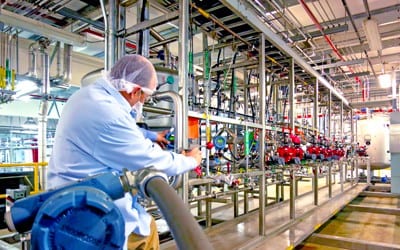
There is no standard price point for an inline blending skid, and they require no less customization than any other modular build. The number of ingredients, number of recipes, expected output, and many other factors must be considered when these skids are designed. So, what drives the cost up? Below are some of the major factors that will determine the final cost of your inline blending system:
1. Number of Ingredients
The number of ingredients is a huge factor in the final price of an inline blending skid because of all the hardware required to add ingredients. There are a lot of different pieces of equipment that not only move each ingredient from point A to point B, but do it accurately, ensuring the quality and integrity of the product is maintained.
2. Number of Recipes
The desired number of recipes has a large impact on price due to the engineering efforts required to ensure each recipe is accurate. Individual recipes require specific amounts of each ingredient; process controls, measurement instrumentation calibration, and accuracy testing – among other engineering – must be completed for each recipe.
3. Accuracy and Performance
Accuracy and performance of the in-line blending system are also key factors when determining price. The more accurate the machine has to be, the more controls, instrumentation and engineering effort required. The same goes for performance. The more output needed, the larger the system must be, and the more work required to ensure maximum output is achievable.
4. Level of automation and integration into previous systems
As I’m sure you can imagine, the more automated you want your in line blending system, the more expensive it gets. Modules that are totally automated and require no human control (other than a key turn), will be obviously pricier than those where the human element is a large part.
Integration into previously existing systems also adds to the price tag, especially if the base control systems are different. Time and effort are spent trying to integrate both the controls and equipment, so the system communicate properly and blending accuracy is not reduced.
5. Operating Conditions
Finally, the last common cost factor is operating conditions. Specifically, what is required to complete your recipe after it’s been mixed. Does it need to be heated? Does it need to be cooled? Does it need to be heated then cooled? Is it going to be piped directly to a filler, or stored in a tank? End-of-line and final processing steps must be considered.
Final Word: Batching vs. In-line Blending
Inline blending systems are useful and effective when the process at hand fits the bill. Sometimes batch mixing systems are the only cost-effective systems that will work for your application. It all comes down to the specific factors of your process..
When flexibility around recipe changes are a must; when you want to reduce the amount of wasted material; if you don’t have enough floor space for many tanks; or if you just want to reduce the number of tanks in your plant, then an in-line blending system may be the perfect solution.
Inline blending systems are not the “cheap” alternative they are often thought to be. So, before you fully commit to an inline blending system, consider the cost factors. Then let us help you put your process technology to work.